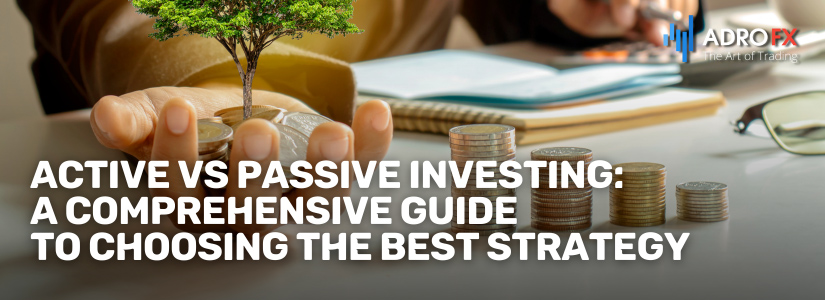Active vs Passive Investing: A Comprehensive Guide to Choosing the Best Strategy

Investing is a crucial aspect of financial planning, and one of the most important decisions investors face is choosing between active and passive investing. This debate - passive vs. active investing - has been at the forefront of the investment world for years. Both strategies have their unique benefits and drawbacks, and understanding them is key to making informed financial decisions.
Active investing involves hands-on management of investments, with the goal of outperforming the market through strategic decisions. On the other hand, passive investing focuses on long-term growth by tracking market indexes and minimizing trading.
Choosing the right strategy between active investing vs. passive investing can significantly impact your financial outcomes. This decision hinges on factors such as your investment goals, risk tolerance, and time commitment. Understanding the differences between these approaches will help you align your investment strategy with your financial objectives.
Understanding Active Investing
Active investing is a strategy where investors frequently buy and sell securities with the goal of outperforming market returns. Unlike passive investing, which aims to replicate market performance, active investing seeks to capitalize on short-term market fluctuations and inefficiencies to achieve superior gains.
Active investors either manage their portfolios themselves or employ portfolio managers who make frequent trades, analyze market trends, and adjust holdings based on changing economic conditions or company performance. This method requires a constant commitment and a profound understanding of financial markets.
Common active investment strategies include selecting individual stocks expected to outperform the market and timing trades to buy low and sell high. Hedge funds, mutual funds, and individual investors often use these techniques in an effort to exceed market averages. However, active investing involves higher costs due to frequent trading and management fees and carries more risk compared to passive investing.
For those who are prepared to handle increased risk and engage extensively with market movements, active investing presents the potential for substantial rewards. Nonetheless, it's crucial to balance these potential benefits with the associated costs and risks.
Understanding Passive Investing
Passive investing is a strategy aimed at achieving market returns by minimizing the frequency of trades. Unlike active investing, which tries to beat the market through strategic buying and selling, passive investing focuses on long-term growth by tracking a market index, such as the S&P 500.
The main principle of passive investing is to maintain a diversified portfolio over time without attempting to time the market or select individual stocks. This strategy is based on the belief that markets are generally efficient, and consistently outperforming them is challenging.
Passive investment strategies typically involve investing in index funds or exchange-traded funds (ETFs) that aim to replicate the performance of a broad market index. These funds offer exposure to a wide array of assets with lower costs and minimal trading.
For investors who prefer a straightforward, cost-effective approach with a long-term perspective, passive investing is an appealing choice. Its focus on diversification, low fees, and reduced risk makes it a favorable option for those looking to steadily build wealth over time.

Active vs. Passive Investing: Key Differences
When comparing active vs. passive investing, several key aspects come into play. Understanding these differences can help investors decide which strategy best suits their financial goals.
- Performance: Active vs. Passive Investing
Active investing aims to outperform the market, but it doesn't always succeed. In contrast, passive investing typically delivers returns that match the market's performance. While active strategies have the potential for higher gains, they also come with the risk of underperforming. Passive strategies, on the other hand, offer more consistent returns aligned with market averages.
- Cost: Active vs. Passive Investment
One of the significant differences between active vs. passive investment is cost. Active investing involves frequent trading and often requires professional management, leading to higher fees and expenses. Passive investing, with its buy-and-hold approach and lower management needs, generally has much lower costs, making it more cost-effective for long-term investors.
- Risk: Passive vs. Active Investment
Active investing can involve higher risk due to the attempt to outperform the market through tactical trades. In contrast, passive investing spreads risk by diversifying across an entire index, reducing the impact of individual stock volatility. This makes passive investing a safer option for those with a lower risk tolerance.
- Flexibility: Active v. Passive Investing
Active investing offers more flexibility, allowing investors to adjust their portfolios in response to market conditions. However, this flexibility can lead to higher costs and increased risk. Passive investing, while less flexible, requires less time and effort, making it ideal for those who prefer a hands-off approach.
By understanding the key differences between active and passive investing, investors can better align their strategies with their financial goals, risk tolerance, and time commitment, ensuring they make informed decisions that support their long-term success.
The Simplicity and Challenges of Active Investing
Active investing is a dynamic approach where investors or portfolio managers make ongoing decisions about buying and selling assets, striving to outperform the market. This hands-on method presents a range of potential benefits but also introduces several challenges.
One of the key attractions of active investing is the opportunity for exceptional returns. By meticulously selecting stocks, timing market movements, and deploying sophisticated strategies, active investors aim to exploit short-term fluctuations and unique market opportunities that passive strategies might overlook. This approach also offers remarkable flexibility, allowing investors to adjust their portfolios swiftly in response to shifting market conditions, economic developments, or emerging information. Additionally, active investing provides the chance for a customized investment strategy, tailored specifically to individual objectives, risk tolerance, and time horizons.
However, the pursuit of higher returns comes with its own set of trade-offs. Active investing typically involves higher costs due to frequent trading, professional management fees, and the expense of in-depth research. These costs can erode potential profits and make it challenging to achieve the desired returns. Furthermore, the drive for superior performance introduces a higher risk level. Active investors may experience greater losses if their strategies do not succeed as anticipated, and the pressure to outperform the market can lead to more aggressive tactics, which may not always yield favorable results. This approach also demands a significant investment of time and expertise, making it best suited for those who can dedicate substantial resources and have the necessary knowledge to navigate the complexities of the market.
The Simplicity and Challenges of Passive Investing
In contrast, passive investing is a more relaxed strategy focused on mirroring the performance of a specific market index or sector through a diversified portfolio. This method prioritizes simplicity and cost-efficiency but also has its limitations.
One of the standout benefits of passive investing is its cost-effectiveness. With fewer transactions and lower management fees, passive strategies such as index funds and ETFs are generally more affordable, enabling investors to retain a larger portion of their returns. The approach also emphasizes reduced risk through broad diversification, which helps mitigate the volatility associated with individual stocks. By tracking a market index, passive investors can enjoy steady returns without the dramatic fluctuations of more aggressive strategies. For those who prefer a low-maintenance investment, passive investing is straightforward and requires minimal effort once the initial investment is made, making it an ideal choice for those with a long-term perspective.
On the flip side, passive investing does not aim to outperform the market, which can be a drawback for those seeking higher gains. Its strategy is designed to track market performance rather than exceed it, which may make it less appealing to investors looking for superior returns. Additionally, passive investors lack the flexibility to swiftly respond to market changes or seize short-term opportunities, which can be a disadvantage during periods of market volatility or economic transitions. This approach may also miss out on potentially lucrative opportunities that active investors might capitalize on.
In summary, passive investing is a strong choice for long-term, hands-off investors who value low costs and reduced risks over the potential for higher returns. It offers a reliable path to gradually building wealth without the intricacies of active management.

When to Choose Active Investing Over Passive Investing
Active investing is not suitable for everyone, but it can be the better choice under specific circumstances. For those with deep market expertise, active investing proves valuable. Seasoned investors or professionals with the ability to analyze trends and make informed decisions may find active strategies appealing. If you enjoy staying informed about market news and have the time to research individual stocks, active investing could align with your interests.
During periods of market volatility, active strategies offer opportunities to capitalize on short-term fluctuations that passive strategies might miss. If you believe certain sectors or stocks will outperform in the near term, active investing provides the flexibility needed to seize those opportunities. For investors seeking higher-than-average returns, active investing may also be appropriate. If your financial goals require rapid capital appreciation, particularly in a bullish market, and you're willing to accept higher risks, active strategies can help you pursue those goals.
In markets that are less efficient or still developing active strategies can uncover undervalued stocks that index funds might overlook. Similarly, during significant economic shifts, such as changes in interest rates, new government policies, or technological advancements, active investing can offer an advantage by allowing investors to adapt to specific industry impacts. In summary, active investing is most effective for individuals with the knowledge and time to navigate complex market environments, especially when seeking higher returns during uncertain periods.
When to Choose Passive Investing Over Active Investing
Passive investing offers simplicity and stability, making it the preferred choice for many, especially in certain scenarios. Long-term investors who focus on wealth accumulation with minimal involvement often find passive investing ideal. It suits those who prefer a hands-off approach and are content with steady returns over time.
During periods of market turbulence, passive strategies provide much-needed stability. By holding diversified assets that track the overall market, passive investors can withstand short-term fluctuations without needing to make frequent adjustments. Cost-conscious investors may also gravitate toward passive strategies, as they typically involve lower costs and fewer trades, helping to preserve returns by minimizing fees.
When markets are volatile, passive investing offers reduced risk by helping investors avoid making emotional decisions during downturns. By adhering to a long-term plan, investors can steer clear of the pitfalls of attempting to time the market. Furthermore, passive investments like index funds and ETFs ensure consistent exposure to the market, allowing you to participate in long-term growth without the stress of active management. In conclusion, passive investing is a strong option for those seeking stability, lower costs, and a less hands-on approach, particularly during periods of volatility.
Also read: Navigating Economic Turbulence: The Nexus Between Political Stability and Forex Markets
Combining Active and Passive Strategies
A hybrid approach that balances both active and passive investing strategies can provide the best of both worlds. By integrating both methods, you can create a diversified portfolio that benefits from the stability of passive investments while taking advantage of the growth opportunities that active strategies offer.
One effective way to balance these strategies is through a core and satellite approach. In this method, passive investments, such as index funds, form the stable core of your portfolio, while active investments, like individual stocks or actively managed funds, act as satellites that target specific opportunities. Another way to combine these strategies is through tactical asset allocation. This approach involves allocating a portion of your portfolio to passive investments for broad market exposure, while active strategies allow you to adjust your holdings based on market conditions or personal convictions about certain sectors.
Real-life examples of investors using a mixed approach include balanced mutual funds, which combine active stock picking with a passive bond index strategy. This blend provides both growth potential and stability. Large institutional investors often use a similar mix, leveraging the consistency of index funds while pursuing additional returns through active management in targeted areas. This hybrid approach enables investors to maintain diversification while capitalizing on market opportunities, aligning their portfolios with varying risk tolerance and financial goals.
Conclusion
Choosing between active and passive investing depends on your financial goals, risk tolerance, and market outlook. Active investing offers the potential for higher returns and flexibility but comes with increased costs and risks. Passive investing, on the other hand, provides stability, lower costs, and reduced risk, making it a good fit for long-term, hands-off investors.
Assess your individual needs and investment objectives to determine which strategy, or combination of strategies, is right for you. Whether you're seeking growth, stability, or a mix of both, aligning your approach with your financial goals is key to successful investing.
Ready to elevate your trading knowledge and explore new opportunities? Dive into the AdroFx blog section for expert insights on CFD trading and a wide range of investment strategies. Discover how trading CFDs with AdroFx can help you maximize your potential and achieve your financial goals. Visit our blog to stay informed and take the next step in your trading journey with AdroFx!
About AdroFx
Established in 2018, AdroFx is known for its high technology and its ability to deliver high-quality brokerage services in more than 200 countries around the world. AdroFx makes every effort to keep its customers satisfied and to meet all the trading needs of any trader. With the five types of trading accounts, we have all it takes to fit any traders` needs and styles. The company provides access to 115+ trading instruments, including currencies, metals, stocks, and cryptocurrencies, which make it possible to make the most out of trading on the financial markets. Considering all the above, AdroFx is the perfect variant for anyone who doesn't settle for less than the best.










